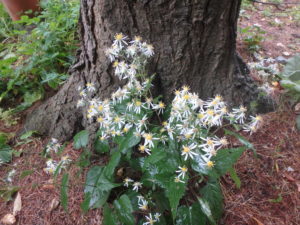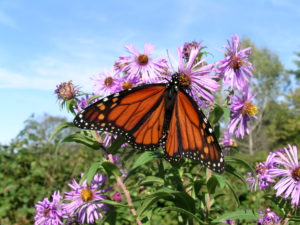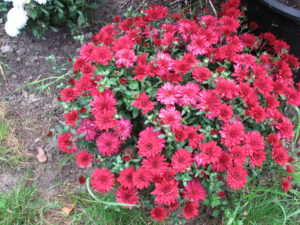Fall Mums and Asters: Joys of the Season
Summer is over, officially, and the garden knows it. Tomatoes exist only in the kitchen, many flowers are looking lackluster, and trees are losing their leaves. What’s a gardener to do? I buy color in the form of chrysanthemums and fall asters. And I also enjoy wild asters that appear along the roadside and the edge of my woods.
Let’s start with asters. My most comprehensive wildflower reference, The Illustrated Books of Wildflowers and Shrubs by William Carey Grimm, lists 29 native species of wild asters. Walking along a country road recently I spotted at least 5 of them. Some were tall and white or purple, others shorter and pink, purple or mauve. Some had wide rays in their flowers, others had delicate rays close together. And I wouldn’t begin to try to assign names to them. They were all lumped together in my mind as just asters. I like them all.
At garden centers there are nice purple asters for sale, short ones, either bright purple or pink. Their tags will say they are perennials, and they are. What the tags do not say is that yours won’t have a hundred blossoms or more next year and hug the ground. They will be taller, probably much taller, and have fewer blossoms.
The asters you buy that have been cut back repeatedly in the early summer so that the stems will fork, making them bushier, wider and shorter. Each little stem is capable of producing a blossom. If you want to get something next fall that resembles this year’s purchase, you will need to cut back the plants at least twice in early summer. Me? I leave that to the professionals.
Of the tall perennial asters, I have some that are 5 to 6 feet tall and produce huge numbers of flowers. These are New England asters, a native species. They produce large amounts of pollen and nectar and are important to our butterflies and bees. Monarch butterflies often feed on mine.
In recent times those people who provide us with the botanical names of plants have changed the genus name of asters from Aster to Symphyotrichum . The species name of the common New England aster still remains novae-angliae. Why do they do that? I suppose because they can, and to show that they know a lot more than we do about certain things. Huh.
Another aster I love is the bushy or rice-button aster (Symphyotrichum dumosus). Its lower leaves don’t seem to be affected by the fungal disease that so often turn New England aster stems brown. Its leaves and stems are shiny and a very dark green. It is usually the last aster to bloom for me, only starting in late September or early October. The variety I purchased is known as ‘Wesley Williams’. It is 4-6 feet tall, with intensely purple-blue flowers about an inch across. Like many tall things, it needs to be staked to prevent flopping, particularly in rich soils where it grows tallest.
Each fall I treat myself to some chrysanthemums. The genus name of mums, by the way, has now changed to Dendranthema. I don’t buy them at the grocery store in an effort to get the cheapest price. I go to my local farm stand and buy the biggest, most beautiful pots of mums I can. I like to support local farmers and garden centers – and I believe I get better quality flowers from them. Mums that have traveled on a truck from New Jersey aren’t necessarily of bad quality, but those that were grown near home are less likely to have been stressed or damaged by too little (or too much) water.
Sometimes I just plunk those mums down, pots and all, on the front steps. Doing so means I will have to water them every hot sunny afternoon, particularly if the mums are growing in peat pots instead of plastic ones. I like peat pots – they don’t use any petroleum products – but they do dry out more quickly than plastic. This is true even if you plant the pots in the ground. The lip of a peat pot will let moisture evaporate and dry out the roots unless the ground is pretty wet. So tear off the lip of the peat pot, or remove it entirely if popping them in the ground.
Mums, like the asters, are sold after extensive grooming and pruning throughout the summer. I once estimated that there were 300 blossoms on one 8-inch wide pot of mums. Left to come back next year, you might get a tenth as many blossoms. What you see when you buy your mums is what you’ll get: they will not grow anymore blossoms, but the buds should all open.
Other fall perennials currently in bloom for me include various black-eyed Susans, turtlehead, fall anemones and snakeroot (Cimicifuga ramosa). So I shouldn’t be lamenting the lack of color – besides, it won’t be long before the maples and other trees start their annual show.
Henry is the author of 4 gardening books, and a regular blogger at www.dailyUV.com. He lives and gardens in Cornish Flat, NH. Reach him at henry.homeyer@comcast.net or PO Box 364, Cornish Flat, NH 03746. If you want a letter response, please include a SASE.





